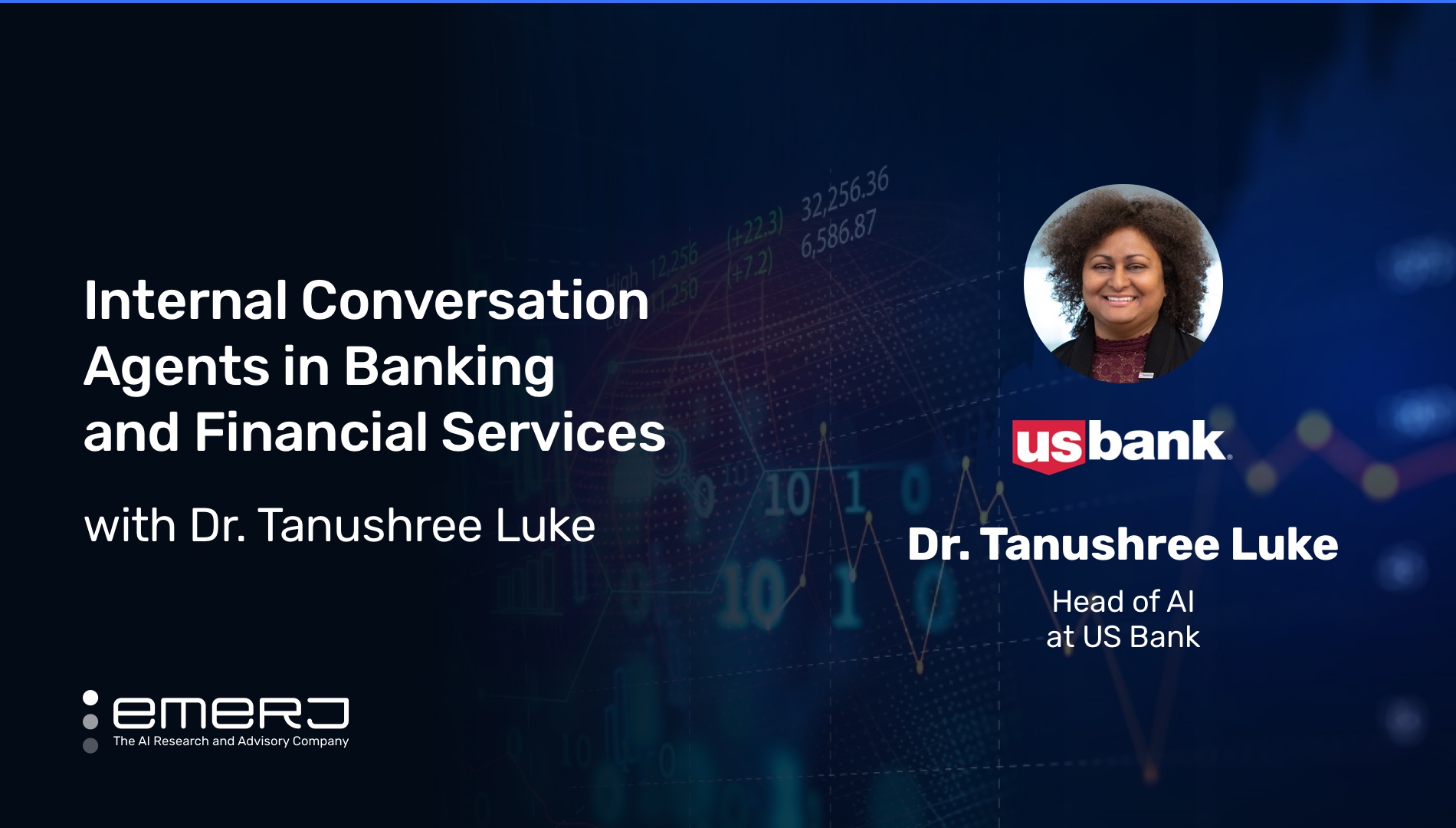How to Rethink Banking in the Age of AI – with Ian Wilson, Former Head of AI at HSBC
Banks and banking AI vendors turn to Emerj to help them maximize ROI by allocating their funds to the most high-need areas. Our research also helps them make smarter decisions by identifying the projects that are more accessible and have the highest chance of resulting in near-term financial returns.
While we supply a lot of valuable data and research, our insights would be worthless if they weren’t corroborated by the testimony of AI and banking leaders working on the ground.
Emerj CEO Daniel Faggella recently sat down with Ian Wilson, the former Head of AI at HSBC, to discuss a range of topics surrounding AI in banking. In their conversation, they dive into why banks choose to focus on certain areas of AI over others and the obstacles that exist to turning ideas about AI into working solutions.
Ian also taps into his experience in HSBC to provide advice to bankers about how to overcome these challenges and foster an environment in which business leaders can drive successful AI adoption across a range of domains. The discussion touches upon a variety of AI use cases in risk management, business development, and customer service.
Listen to the full episode below or skim our interview takeaways and the full interview transcript below:
Guest: Ian Wilson, current Chief Innovation Officer at Nag.
Expertise: AI in banking, finance, management
Brief Recognition: Before becoming HSBC’s Global Director of Artificial Intelligence in May 2017, Ian was the founder and CEO of EmotionAI in 2008, a company that developed emotionally intelligent smart products using AI and Computational Science. Afterward, Ian served as Representative Director for Skimlinks’s Japan Operations as well as a Lead Consultant for Digital Reasoning, based in London. Ian now serves as Managing Director of Strategy 4AI.
Interview Highlights:
- Risk is currently the primary domain of AI applications in banking as it has an established set of problems that can be solved with AI, and strong financial incentives in the form of fines for non-compliance.
- AI adoption in banking begins with ad-hoc solutions to concrete business problems like reducing the number of false-positive fraud alerts or improving on existing manual processes.
- Truly innovative banking AI solutions that shake up banks’ way of doing business arise when bankers have access to the right data infrastructure and possess adequate knowledge of AI capabilities.
- Many creative ideas about AI use cases to improve operations already exist within banks but the main barrier to implementing them is lack of data infrastructure and perceived lack of capability to implement them.
- Educating bankers about the possibilities of AI and creating a framework for idea exchange between people with business and technical expertise are the most important aspects of successfully fostering an environment for banking AI innovation.
Full Interview Transcript
Daniel Faggella: Hi Ian! Good to have you on the show again — let’s dive right in. Our first question is why are the most resources within banks going towards AI for risk management rather than other applications.
Ian Wilson: I think this is very much to do with the fact that risk was already ahead of the game in terms of looking at more advanced types of technology to solve problems. While their jobs may seem very complex, in reality a lot of risk managers’ time is spent reviewing alerts and identifying false positives.
The technologies that they use for this are pretty antiquated and not very good at spotting the types of things that they’re looking for: fraud in transactions, nefarious behavior in communications from their own internal teams and traders.
Another explanation is that since the financial crisis banks have been getting hammered with fines for tens of billions of dollars. There is a large financial incentive to deploy solutions that will stop those fines. Regulators are cracking down on banks and telling them that they will face 10-times the fine next time or have their banking licenses revoked for certain areas of their business.
HSBC entered an agreement with the Department of Justice with the threat of having their license to operate dollars revoked hanging over their heads.
Another reason is that with risk, banks are using AI to replace legacy capabilities that are inefficient as opposed to other banking domains where AI is deployed to create new capabilities. With risk there’s more of an established structure in place, as well as funding and a production deployment team.
There’s a clear objective such as reducing the number of false positives, which makes an existing process more efficient.
Daniel Faggella: Yes it seems like a natural fit in terms of the application of the technology…when there’s already an IT infrastructure that exists and talent working on this issue, as well as a clear problem to solve and regulatory incentives in the form of fines.
Do you think it was the right move for banks to focus their attention on AI applications for risk and compliance first or should they have looked elsewhere?
Ian Wilson: I think it’s neither right or wrong but rather a happy coincidence that AI happened to be an apt means to solving existing problems in compliance and risk. It wasn’t a part of any intentional AI strategy but rather an ad-hoc application of new technology to find solutions to existing problems.
Daniel Faggella: It seems like that’s a natural first step but now we’re seeing this shift in focus from risk and compliance towards improving broader efficiencies. Banks are under a lot of pressure from fintechs and the digital shift to be more innovative.
It seems like the natural next step would be for banks to focus on AI solutions that reimagine their services rather than focusing on marginal improvements to their existing operations. How do banks shed the business-as-usual mindset and foster a culture of innovation to reinvent consumer lending, customer services, etc?
Ian Wilson: Fostering a culture of innovation is certainly important but new ways of working don’t always get traction. The real change will come when AI capabilities become widely available across different banking verticals and bankers will see a potential for tools that improve operational efficiency or reduce costs in different domains.
These can be tools that reduce the loan processing time or improve financial trading. People will want to apply these solutions and that will lead to a more active reimagining of the business.
Daniel Faggella: In short, as functional leaders in banking get more exposure to AI, gain access to the data infrastructure necessary for AI solutions, and communicate with data scientists they will be able to come up with new AI use cases for banking.
This osmosis between the banking and technology communities will allow the bankers to take the lead on generating AI ideas.
Ian Wilson: Very much so! I’ve spoken with people at HSBC which have ideas for new AI use cases but they are still just dreams in their mind. For example, this one group head who described how his group manually looked for prospective commercial banking clients.
This boiled down to essentially pulling a few names out of a hat out of millions of potential clients. People involved in the process were very interested in finding an automated solution for this but they had no idea where to start.
That’s where the osmosis of ideas comes in…once people on the banking side find out about the technology solutions that exist they begin to generate creative ideas for how to apply them within their domain.
Daniel Faggella: You’re saying that many ideas for AI use cases already exist within banks but are currently just pipe dreams because the data infrastructure to make them happen isn’t there. Do you think it’s too optimistic to say that making some of these ideas come to life is mostly about getting in place the right data infrastructure and technical understanding of how to implement them?
In short, as functional leaders in banking get more exposure to AI, gain access to the data infrastructure necessary for AI solutions, and communicate with data scientists they will be able to come up with new AI use cases for banking. This osmosis between the banking and technology communities will allow the bankers to take the lead on generating AI ideas.
Ian Wilson: Very much so! I’ve spoken with people at HSBC which have ideas for new AI use cases but they are still just dreams in their mind. For example, this one group head who described how his group manually looked for prospective commercial banking clients. This boiled down to essentially pulling a few names out of a hat out of millions of potential clients.
People involved in the process were very interested in finding an automated solution for this but they had no idea where to start. That’s where the osmosis of ideas comes in…once people on the banking side find out about the technology solutions that exist they begin to generate creative ideas for how to apply them within their domain.
Daniel Faggella: You’re saying that many ideas for AI use cases already exist within banks but are currently just pipe dreams because the data infrastructure to make them happen isn’t there. Do you think it’s too optimistic to say that making some of these ideas come to life is mostly about getting in place the right data infrastructure and technical understanding of how to implement them?
Ian Wilson: I think [there are] two aspects.
Number one is within your organization, you must have an AI function that can educate. And I think for me, a lot of people when they think about rolling AI into an enterprise or a bank, they think about it more from the technical perspective.
For me, the number one element of running AI in a bank is education, that process of flowing out that the understanding of what those capabilities can do into the bank to make it part of the DNA. And so that’s where you start enabling these people that had these ideas, to realize that now, actually, there may be a capability to actually realize those ideas.
And we mentioned earlier the second point, I think, is also this innovation function. Now, often innovation gets maligned, but I think it’s important to have that there because innovation becomes a structure through which you can start potentially developing those ideas.
So obviously, a lot of people within each business line, they may have an idea, but because they’re not technical, they have no way of knowing how to get the ball rolling to even test that out and see whether it’s feasible.
So I think it’s also important to have that structure in place and have that also understood throughout the business that there is this structure and framework in place. So if you have an idea, you can hand that over to a team that knows how to pick it up and start testing it out and tie those elements together.
So I think those are probably the two key points, I would say but by far for me, the most important element is education.
Daniel Faggella: Big time. Well then, that’s sort of what we’re doing here.







